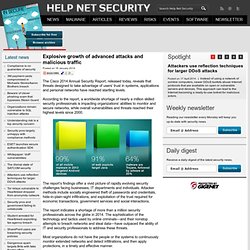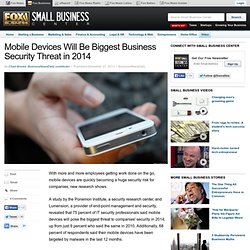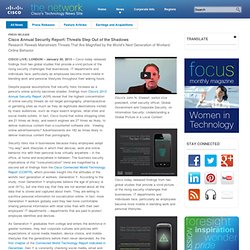

State of California - Department of Justice - Kamala D. Harris Attorney General. Advances in online technology have made many of the day-to-day tasks of running a small business substantially easier. Even traditional brick and mortar stores have come to benefit from these advances through services like low cost, Internet enabled point of sale (POS) systems or cloud-based payroll and inventory services that process and store sensitive data that previously resided on local hard drives or in filing cabinets. These technological advances offer many advantages, but have also introduced a number of new security risks. Malicious mobile apps on Google Play up 400 percent. RiskIQ announced research findings on the presence of malicious apps contained in the Google Play store.

The company found that malicious apps have grown 388 percent from 2011 to 2013, while the number of malicious apps removed annually by Google has dropped from 60% in 2011 to 23% in 2013. Apps for personalizing Android phones led all categories as most likely to be malicious. The most downloaded malicious app in 2013 was Subway Surfer Free Tips.
For this survey, RiskIQ only counted Android apps in the Google Play store as malicious if they are/contain spyware and (SMS) Trojans that: Collect and send GPS coordinates, contact lists, e-mail addresses etc. to third partiesSend SMS messages to premium-rate numbersSubscribe infected phones to premium servicesRecord phone conversations and send them to attackersTake control over the infected phoneDownload other malware onto infected phones. Malware. 2013 Cost of Data Breach Study from Ponemon and Symantec. Analyzing Latest Ponemon/Symantec Cost of Data Breach Study ACQ Subscribe Regulations initially cause organizations to spend more funds on data breaches, but eventually those rules could save enterprises money, the Ponemon Institute's Larry Ponemon says in analyzing his latest study on breach costs.

The 2013 Cost of Data Breach Study, which the institute conducted for IT security provider Symantec, pegs the average global cost of a data breach at $136 a record in 2012, up $6 from in 2011. The study estimated the breach cost per record in the United States averaged $188 in 2012, down from $194 in 2011. Bad behavior, not malware, puts more of your corporate data at risk. Although viruses and other malware apps still plague businesses, it is the poor habits of a company's employees that cause the most problems for corporate security staff.

We all know that employees do dumb things and will continue to do so, no matter what we, as IT, try to do about it. There's no amount of lockdown that can prevent stupid*. A combination of training and strict policy are the only hopes for preventing chaos. A recent report released by Globascape "reveals that employees rely on unsecured, consumer-grade tools to send sensitive corporate documents". The survey consisted of responses from more than 500 professionals and yielded some interesting and disturbing results: Offers Small Businesses a Way to Reduce the Cost of Cyber Crime. WARREN, NJ, August 26, 2013 — To help small businesses survive a data breach, the Chubb Group of Insurance Companies is offering its cyber liability insurance customers an incident response plan template through eRisk HUB®, its Web-based risk management portal.

“Our research has shown that only about one-third of private companies have an incident response plan for data breaches,” said Ken Goldstein, vice president and worldwide cyber security manager for Chubb. “Many small businesses may not have the resources or expertise to develop such a plan, leaving them exposed to the disruption of a data breach and costly first-party expenses, legal ramifications, and regulatory fines and penalties.” The gentle art of cracking passwords. 1 December 2013Last updated at 21:19 ET By Mark Ward Technology correspondent, BBC News If you have a cat, or any other type of pet, do not use its name as part of a password On the internet, the most popular colour is blue, at least when it comes to passwords. If you are wondering why, it is largely because so many popular websites and services (Facebook, Twitter and Google to name but three) use the colour in their logo.
That has a subtle impact on the choices people make when signing up and picking a word or phrase to form a supposedly super-secret password. It's just one of the many quirks to be found in the password-picking habits of us humans. These studies also reveal that when it comes to passwords, women prefer length and men diversity. Explosive growth of advanced attacks and malicious traffic. Posted on 16 January 2014.

The Cisco 2014 Annual Security Report, released today, reveals that threats designed to take advantage of users’ trust in systems, applications and personal networks have reached startling levels. According to the report, a worldwide shortage of nearly a million skilled security professionals is impacting organizations’ abilities to monitor and secure networks, while overall vulnerabilities and threats reached their highest levels since 2000. The report’s findings offer a vivid picture of rapidly evolving security challenges facing businesses, IT departments and individuals. Malware. Www.pwc.com/en_US/us/increasing-it-effectiveness/publications/assets/us-state-of-cybercrime.pdf. Www.nsba.biz/wp-content/uploads/2013/09/Technology-Survey-2013.pdf. Verizon Enterprise Solutions: Verizon DBIR - Smarter security: can your business keep up?
Mobile Devices Will Be Biggest Business Security Threat in 2014. With more and more employees getting work done on the go, mobile devices are quickly becoming a huge security risk for companies, new research shows.

To detect 100 percent of malware, try whitelisting 'lite' Every antimalware scanner claims to catch 99 to 100 percent of malware.

But how can that be true? If it were, our computers wouldn't get infected nearly as much as they do, and the antimalware industry would have roundly defeated its malicious foes by now. Tests against real-world malware show that, over time, even the best scanners miss a significant portion of the total. That's understandable. Annual Security Report: Threats Step Out of the Shadows. Research Reveals Mainstream Threats That Are Magnified by the World's Next Generation of Workers' Online Behavior.
